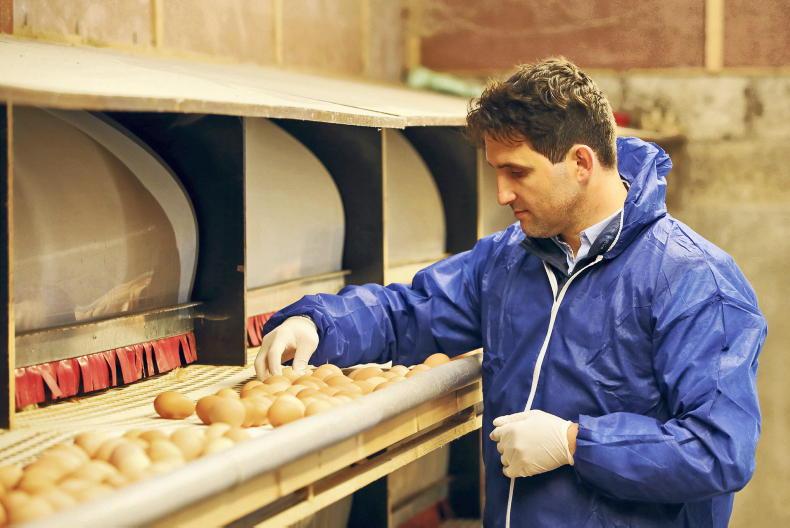The increase in egg consumption that began during the pandemic has continued, providing a popular, cheap, easy-to-cook source of protein.
As a result of consumer demand, the majority of retail shell eggs produced in Ireland are free range, although enriched cages, barn and organic eggs are available.
Free-range birds are considered to be high welfare, as hens have daytime access to vegetation, allowing them to display natural behaviours before coming in to roost at night.
Assurance schemes in Northern Ireland and the Republic of Ireland monitor farms and many supermarkets have their own additional production and welfare criteria.
There is a current trend to extend the hens’ laying period from 70-plus weeks to around 80 weeks or more to promote greater sustainability within the industry.
The challenge of maintaining the same level of welfare and productivity in older birds is being met by improved genetics, feed management and a proactive approach to health.
“Effective protection against disease through vaccination is the foundation of a healthy flock,” explained Conor Sheehy, business unit director for poultry at MSD Animal Health.
“Hens will receive vaccines for up to 12 different diseases before they begin laying. With the average flock remaining on laying farms for longer, it is vital that the correct vaccines are used correctly to provide immunity persisting throughout the life of the bird.
"MSD has invested in reformulating our vaccine range to provide immunity to the most common diseases for at least 80 weeks post transfer to the laying farm.”
All hens are susceptible to both internal and external parasites. Unlike worms affecting ruminants, poultry worms do not complete part of their life cycle in pasture.
As such, grass management cannot be used to control poultry worms. Cleaning and disinfection to reduce worm burden when birds first enter houses is practised throughout industry, but worms still present an ongoing challenge.
Free range
Free-range birds mostly acquire a parasitic worm burden by ingesting eggs or infective larvae directly from the ground, whereas worm eggs and larvae are introduced to housed birds via human footwear and clothing, feedbags or equipment.
Once introduced, they can survive and thrive in the ideal conditions in the litter at all times of the year. The worm life cycle means that birds can acquire infection and 21 to 28 days later shed eggs that further infect the flock and repeat the cycle.
Worms affect production because the inflamed intestine has reduced ability to absorb nutrients. Visible signs of ill thrift with pale combs and runny manure are indicators of a worm burden that can be confirmed via a faecal egg count (FEC) from a pooled sample.
Good news
The good news for farmers is that treatment is quick and simple, and farmers will start to see an improvement quite quickly, even in older birds.
Vets can prescribe an appropriate worming treatment that is easy to administer via the drinking water. Improving hen health following the reduction in worm burdens improves feed efficiency and results in longer peak laying performance.
Poultry red mite are an ectoparasite that is thought to affect 83% of hens in Europe, with a cost to the industry of more than €360m.
Poultry red mite suck blood from host birds at night and then hide in the cracks, crevices and litter of poultry houses when they are not feeding during the day.
Red mites survive and reproduce at a wide range of temperatures, but at 17°C to 25°C and around 70% humidity, their life cycle is shorter, meaning that populations can rapidly increase in the right conditions.
While small numbers of mites may be tolerated by laying hens, heavy infestations result in reduced productivity due to anaemia, decreased quality and quantity of eggs produced, reduced growth in younger birds and reduced immunity leading to the presence of other diseases. Mites are also known to carry a multitude of viral and bacterial pathogens that can be transmitted to both birds and humans, including E coli, salmonella and listeria.
Mites cause pecking among birds that may result in injury and, as the mites attack at night, the hens’ sleep is disturbed and they become restless and noisy and have been shown to suffer high stress levels due to these painful bites. This adds to the welfare significance of infestation with red mites.
These health issues also affect egg production: more downgraded eggs in the packing station, higher rates of floor eggs and the laying pattern may be more spread out. Farmers may see a reduction in the laying rate, compared either to previous flocks or to the wholesaler’s average.
Treatments

A systemic treatment containing fluralaner, is available for the control of poultry red mite infestations. Treatment consists of two applications (via the drinking water), seven days apart, in order to target all stages of the life cycle. The egg withdrawal period is zero days.
This novel product was the first veterinary product centrally registered in the EU to include animal welfare improvement in its licence. Studies in commercial layer farms demonstrated that the elimination of poultry red mite from infested hens following treatment significantly improved behavioural indicators of animal welfare.
“Increasing consumer demand for sustainability and welfare means the industry is adapting to meet the needs of packers and retailers. As the productive life of the hen is being extended beyond 80 weeks, vets and farmers are working together to support her to stay healthy and productive.
"Freedom from internal and external parasites allows the hens to maximise the energy available to them, meaning less feed is required to produce the same number of eggs and improves the sustainability of this already very efficient, high bioavailability, protein source,” concluded Conor.






 This is a subscriber-only article
This is a subscriber-only article





